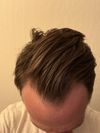community Those who experienced a big shed and stuck to their routine long term (1yr+) - Did a big shed truly mean you got good results down the line?
The conversation discusses hair loss treatments, specifically the use of minoxidil, finasteride, and microneedling, and the experience of shedding hair as a potential sign of treatment effectiveness. Some users report positive results after initial shedding, while others express concerns about long-term hair loss and the effectiveness of treatments.

